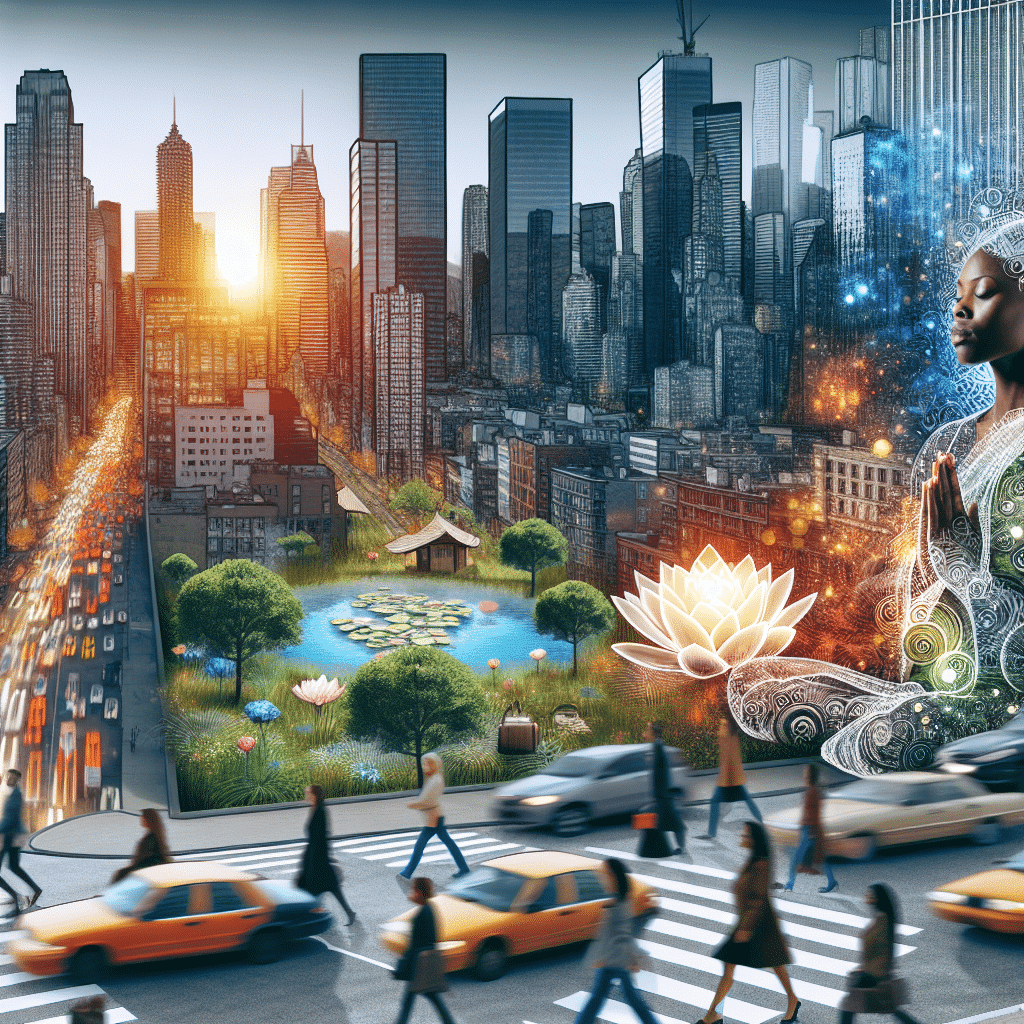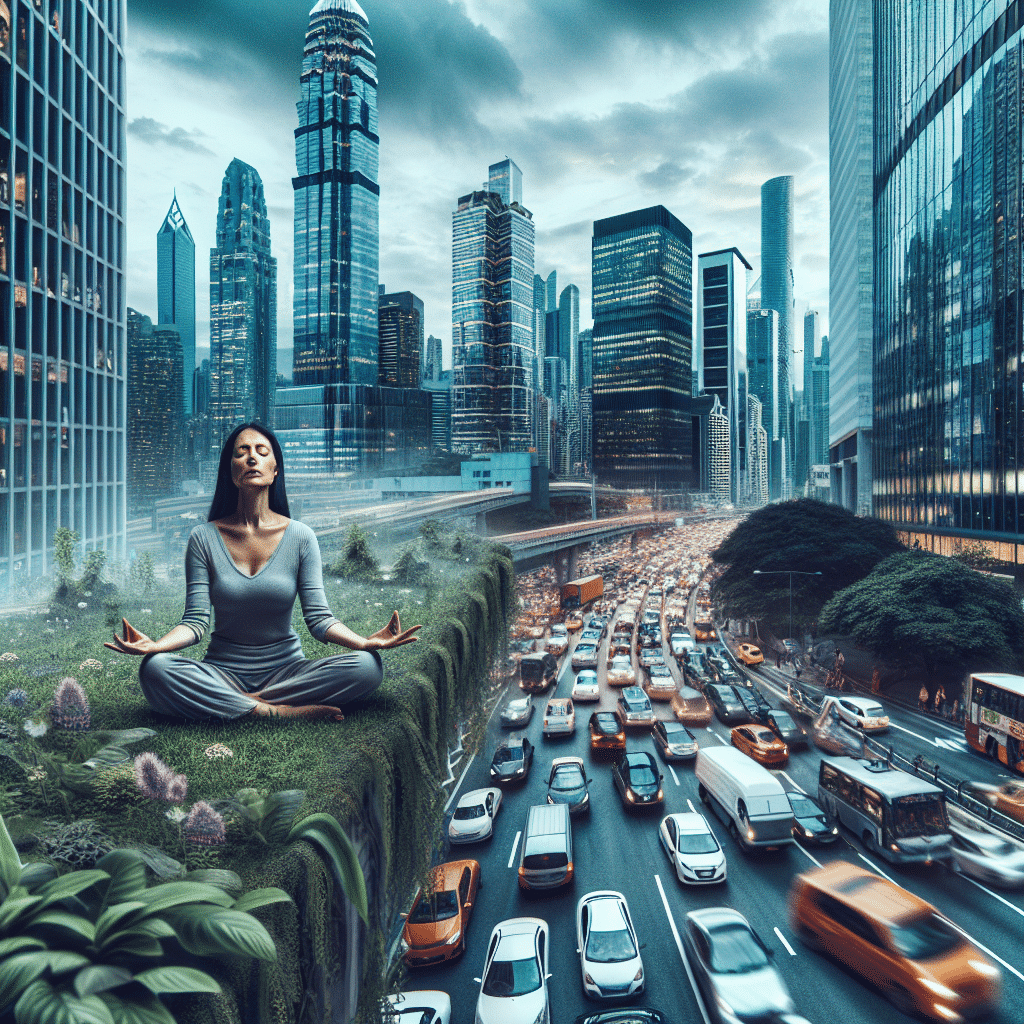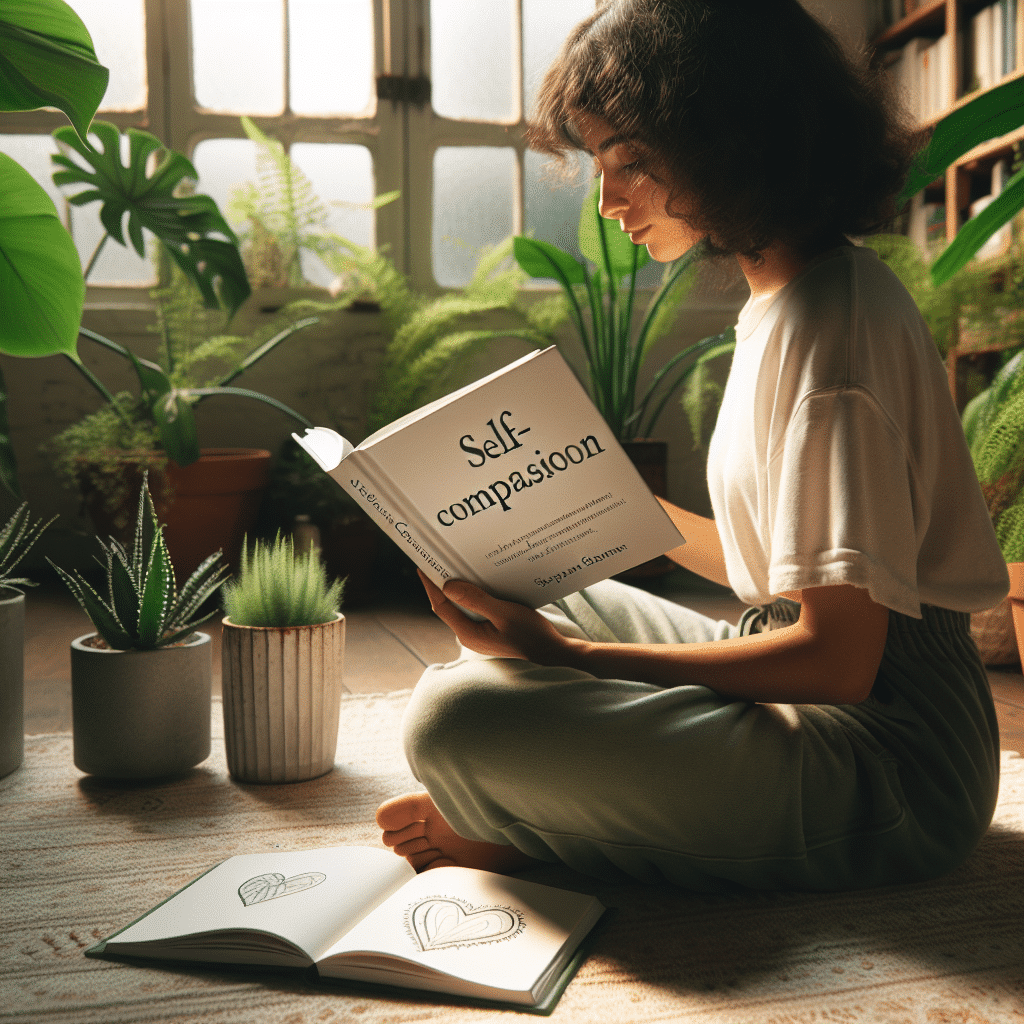
The practice of meditation is experiencing a surge in popularity among urban dwellers, as more people recognize the benefits of this age-old practice for their physical, mental, and emotional well-being. In urban environments that are often fast-paced and stress-inducing, meditation offers a means of finding calm and inner peace amidst the chaos.
Urban meditation has become a growing trend, with meditation studios, classes, and apps popping up in cities around the world. This is no surprise, considering the numerous benefits that meditation can provide in urban settings.
Firstly, meditation can help urban dwellers manage stress. The hustle and bustle of city life can be overwhelming, leading to chronic stress, anxiety, and burnout. Regular meditation practice has been shown to reduce stress levels, promote relaxation, and enhance overall well-being.
In addition to stress reduction, meditation can also improve focus and concentration, which are essential skills for navigating busy urban environments. By training the mind to stay present and avoid distractions, meditation can enhance productivity and performance in various aspects of urban life, whether it be at work or in personal pursuits.
Beyond the individual benefits, urban meditation can also have a positive impact on the community. As more people engage in meditation, a sense of collective mindfulness and compassion can emerge, leading to kinder and more harmonious interactions among urban residents. This can contribute to creating a more compassionate and connected urban society.
However, practicing meditation in urban environments does come with its own set of challenges. Distractions, noise pollution, and limited time and space can make it difficult to find a quiet and peaceful environment for meditation. Additionally, the fast-paced nature of urban life can make it challenging to establish a consistent meditation practice.
Fortunately, there are strategies that urban dwellers can employ to incorporate meditation into their lifestyles. Utilizing technology, such as meditation apps or online classes, can make it easier to practice meditation anytime and anywhere. Finding pockets of quiet and calm within the urban landscape, such as parks or green spaces, can also provide an ideal setting for meditation.
Moreover, creating dedicated urban meditation spaces can be beneficial for both individuals and communities. These spaces can serve as sanctuaries for urban dwellers to escape the noise and chaos of the city and find solace in their meditation practice. Designing such spaces with elements of tranquility and serenity can enhance the meditative experience and encourage regular practice.
In conclusion, urban perspectives on meditation are increasingly recognizing its value in promoting well-being, managing stress, improving focus, and fostering compassion within the community. While urban environments present unique challenges, strategies such as utilizing technology and creating dedicated meditation spaces can help individuals incorporate this practice into their urban lifestyles. Thus, meditation has become an essential tool for urban dwellers seeking balance and inner peace amidst the fast-paced urban landscape.
Benefits of Meditation in Urban Environments
As urban areas become more crowded and stressful, the practice of meditation is experiencing a surge in popularity among city dwellers. The fast-paced nature of urban life often leaves individuals feeling overwhelmed and disconnected, making meditation an appealing solution for finding peace and balance. There are several significant benefits of practicing meditation in urban environments.
1. Stress Reduction
One of the primary benefits of meditation is its ability to reduce stress. Urban life can be incredibly hectic, with constant noise, traffic, and social pressures. Engaging in regular meditation allows individuals to quiet their minds, focus on their breath, and bring about a sense of calm. By incorporating meditation into their daily routine, urban dwellers can effectively manage stress and improve their overall well-being.
2. Mental Clarity
Living in a bustling city often means dealing with a constant barrage of information and stimuli. This can lead to a cluttered mind and difficulty focusing. Meditation provides an opportunity to quiet the mind and cultivate mental clarity. By regularly practicing meditation, individuals can train their minds to stay focused and present, enhancing their ability to concentrate and make clear decisions, even in the midst of urban distractions.
3. Emotional Regulation
The fast-paced nature of urban environments can sometimes leave individuals feeling overwhelmed and emotionally drained. Meditation offers a valuable tool for emotional regulation, allowing individuals to become more aware of their emotions and respond to them in a healthy and balanced way. By practicing meditation regularly, urban dwellers can cultivate emotional resilience and improve their overall emotional well-being.
4. Increased Self-Awareness
Urban living often involves constantly moving from one task to another, leaving little time for self-reflection. Meditation provides an opportunity for individuals to pause, connect with themselves, and increase self-awareness. Through regular meditation practice, urban dwellers can develop a deeper understanding of their thoughts, feelings, and behaviors, resulting in improved self-knowledge and personal growth.
In conclusion, practicing meditation in urban environments can have numerous benefits for individuals seeking to find peace and balance amidst the fast-paced nature of city life. By reducing stress, enhancing mental clarity, regulating emotions, and increasing self-awareness, meditation offers valuable tools for urban dwellers to navigate the challenges of urban living and improve their overall well-being.
Challenges of Practicing Meditation in Urban Settings
While meditation offers numerous benefits for urban dwellers, there are also unique challenges that come with practicing this ancient practice in a bustling city environment.
Noise Pollution
One of the biggest challenges of meditating in urban settings is the presence of noise pollution. The constant honking of car horns, sirens blaring, and construction noise can make it difficult to find a quiet space for meditation. These distractions can make it hard to achieve the level of focus and concentration necessary for a successful meditation session.
To overcome this challenge, urban meditators can try using noise-canceling headphones or earplugs during their practice. They can also explore alternate locations such as public parks or gardens that offer a quieter and more serene atmosphere.
Limited Space
Urban environments often lack spacious areas for meditation, which can be a hindrance for those looking to practice meditation. In crowded cities, finding a quiet spot where one can comfortably sit without interruption can be a challenge.
To address this issue, some urban dwellers opt for alternative seating arrangements such as using meditation cushions or benches in smaller spaces. Others may choose to convert a small corner of their apartment or office into a designated meditation area. These creative solutions help individuals make the most of the limited space available to them and create a peaceful environment for their meditation practice.
Inconsistent Routines
Urban lifestyles are often characterized by hectic schedules and irregular routines. This inconsistency can make it challenging to establish and maintain a regular meditation practice.
To combat this issue, urban meditators can integrate meditation into their existing routines. This may involve waking up a few minutes earlier in the morning to meditate before the day’s activities begin or incorporating short meditation breaks during the workday. Setting aside specific times for meditation and treating it as a priority can help overcome the inconsistencies of urban life and ensure a dedicated practice.
Despite these challenges, urban dwellers can still experience the transformative benefits of meditation by adapting and finding innovative solutions that work for their individual circumstances. By exploring different techniques and strategies, individuals can incorporate meditation into their urban lifestyles and reap its rewards.

Strategies for Incorporating Meditation into Urban Lifestyles
Living in a bustling city can often make finding time and space for meditation challenging. However, with the right strategies and mindset, it is possible to incorporate meditation into urban lifestyles. Here are some effective ways to practice meditation in the midst of a busy city:
Create a Daily Routine
Establishing a regular meditation practice starts with prioritizing it in your daily routine. Set aside a specific time each day that works best for you, whether it’s early in the morning before the city wakes up or in the evening when the streets are quieter. Making meditation a non-negotiable part of your schedule helps ensure that it becomes a consistent habit.
Find Quiet Spaces
While urban environments are often loud and chaotic, there are still pockets of tranquility to discover. Seek out quiet parks, gardens, or even quiet corners of coffee shops where you can escape the noise and find a sense of calm. Embrace these havens as your personal meditation sanctuaries and make use of them during your meditation practice.
Adapt to Your Surroundings
Meditation doesn’t always have to be done in complete silence or solitude. Embrace the sounds and energy of the city as part of your meditation practice. Instead of trying to shut out the noise, incorporate it into your mindfulness practice. Focus on the sounds of traffic, voices, and other urban noises as background noise that can help you cultivate a sense of present-moment awareness.
Use Guided Meditations
For those who find it difficult to meditate in noisy urban settings, using guided meditations can be beneficial. Many meditation apps and websites offer a variety of guided meditation tracks specifically designed for urban dwellers. These guided meditations often provide techniques for grounding yourself in the present moment despite the distractions of the city.
Join Group Meditations
Being part of a meditation group or class can offer support and motivation, especially in urban areas where it can be challenging to find like-minded individuals. Seek out local meditation groups or studios that offer urban-focused meditation classes or workshops. Not only can this provide a sense of community, but it can also offer the opportunity to learn from experienced teachers and practitioners.
Practice Mindfulness Throughout the Day
While a dedicated meditation practice is important, incorporating mindfulness into your everyday activities is equally valuable. Take moments throughout the day to bring your attention to the present moment, whether it’s during your commute or while waiting in line. By cultivating a mindful approach to city living, you can experience the benefits of meditation even in the midst of urban chaos.
By implementing these strategies, urban dwellers can successfully incorporate meditation into their busy lifestyles. Remember, meditation is a flexible practice that can be adapted to any environment. With consistency and open-mindedness, it is possible to find peace and calm amidst the urban chaos.
Creating Urban Meditation Spaces
As the trend of meditation continues to grow in urban environments, there is a need for dedicated spaces that cater to the needs of city dwellers seeking a sanctuary for their practice. Creating urban meditation spaces can help individuals find tranquility and peace amidst the hustle and bustle of city life. Here are some strategies for designing and implementing these spaces:
1. Identify Suitable Locations
The first step in creating urban meditation spaces is to identify appropriate locations within the city. Look for areas that are relatively quiet, away from heavy traffic or loud noises. Parks, rooftop gardens, or abandoned buildings that can be transformed into serene spaces are great options to consider.
2. Design for Serenity
The design of urban meditation spaces should prioritize tranquility and serenity. Incorporate elements such as natural materials, soft lighting, and calming colors to create a peaceful environment. Use soundproofing techniques to minimize external noises and provide a sense of isolation from the urban chaos.
3. Provide Amenities
Urban meditation spaces should offer amenities that enhance the meditation experience. Comfortable seating options, such as cushions or ergonomic chairs, can help individuals find a relaxed posture for their practice. Providing water dispensers, tea stations, or soothing music can also contribute to the overall ambiance of the space.
4. Implement Mindfulness Practices
Integrating mindfulness practices into urban meditation spaces can offer individuals a holistic experience. Consider incorporating features like meditation gardens, Zen walking paths, or labyrinth designs that encourage mindful movement and contemplation. These elements can enhance the overall meditation experience and promote a deeper connection with the present moment.
5. Accessibility and Inclusivity
It is essential to ensure that urban meditation spaces are accessible and inclusive for all individuals. Consider providing ramps or wheelchair-accessible entrances for individuals with mobility challenges. Make the space welcoming and inclusive of different cultures, religions, and meditation practices.
6. Offer Guided Meditation Sessions
Hosting guided meditation sessions in urban meditation spaces can help individuals who are new to meditation or those seeking guidance in their practice. These sessions can be led by experienced meditation teachers or practitioners and provide a structured environment for individuals to explore and deepen their meditation practice.
By creating dedicated spaces that cater to urban perspectives on meditation, individuals can find solace, relaxation, and inner peace amidst the urban chaos. These spaces allow for a deeper connection to oneself and the surrounding environment, promoting overall well-being in today’s fast-paced urban lifestyle.

Summary
The practice of meditation is becoming increasingly popular in urban environments, as more people recognize the need for inner peace and mindfulness amidst the busyness of city life. Urban meditation offers a range of benefits, including stress reduction, improved focus, and enhanced overall well-being. However, practicing meditation in urban settings also presents unique challenges, such as noise and distractions. To overcome these obstacles, individuals can adopt strategies like finding quiet spaces, incorporating mindfulness into everyday activities, and utilizing technology for guided meditation. Furthermore, the creation of dedicated urban meditation spaces can provide a peaceful sanctuary for practicing meditation in busy cities.






